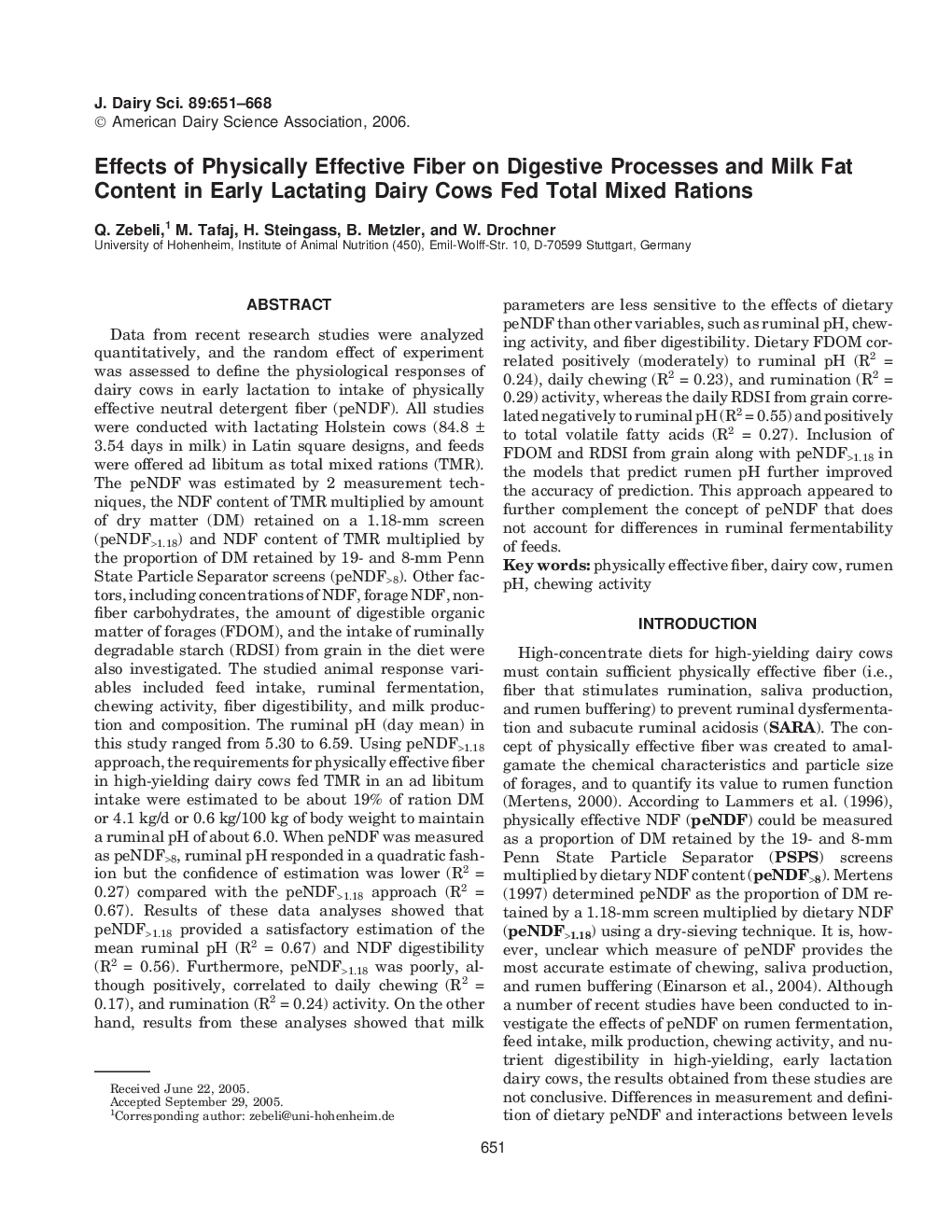| کد مقاله | کد نشریه | سال انتشار | مقاله انگلیسی | نسخه تمام متن |
|---|---|---|---|---|
| 2441220 | 1108134 | 2006 | 18 صفحه PDF | دانلود رایگان |

Data from recent research studies were analyzed quantitatively, and the random effect of experiment was assessed to define the physiological responses of dairy cows in early lactation to intake of physically effective neutral detergent fiber (peNDF). All studies were conducted with lactating Holstein cows (84.8 ± 3.54 days in milk) in Latin square designs, and feeds were offered ad libitum as total mixed rations (TMR). The peNDF was estimated by 2 measurement techniques, the NDF content of TMR multiplied by amount of dry matter (DM) retained on a 1.18-mm screen (peNDF> 1.18) and NDF content of TMR multiplied by the proportion of DM retained by 19- and 8-mm Penn State Particle Separator screens (peNDF> 8). Other factors, including concentrations of NDF, forage NDF, non-fiber carbohydrates, the amount of digestible organic matter of forages (FDOM), and the intake of ruminally degradable starch (RDSI) from grain in the diet were also investigated. The studied animal response variables included feed intake, ruminal fermentation, chewing activity, fiber digestibility, and milk production and composition. The ruminal pH (day mean) in this study ranged from 5.30 to 6.59. Using peNDF> 1.18 approach, the requirements for physically effective fiber in high-yielding dairy cows fed TMR in an ad libitum intake were estimated to be about 19% of ration DM or 4.1 kg/d or 0.6 kg/100 kg of body weight to maintain a ruminal pH of about 6.0. When peNDF was measured as peNDF> 8, ruminal pH responded in a quadratic fashion but the confidence of estimation was lower (R2 = 0.27) compared with the peNDF> 1.18 approach (R2 = 0.67). Results of these data analyses showed that peNDF> 1.18 provided a satisfactory estimation of the mean ruminal pH (R2 = 0.67) and NDF digestibility (R2 = 0.56). Furthermore, peNDF> 1.18 was poorly, although positively, correlated to daily chewing (R2 = 0.17), and rumination (R2 = 0.24) activity. On the other hand, results from these analyses showed that milk parameters are less sensitive to the effects of dietary peNDF than other variables, such as ruminal pH, chewing activity, and fiber digestibility. Dietary FDOM correlated positively (moderately) to ruminal pH (R2 = 0.24), daily chewing (R2 = 0.23), and rumination (R2 = 0.29) activity, whereas the daily RDSI from grain correlated negatively to ruminal pH (R2 = 0.55) and positively to total volatile fatty acids (R2 = 0.27). Inclusion of FDOM and RDSI from grain along with peNDF> 1.18 in the models that predict rumen pH further improved the accuracy of prediction. This approach appeared to further complement the concept of peNDF that does not account for differences in ruminal fermentability of feeds.
Journal: Journal of Dairy Science - Volume 89, Issue 2, February 2006, Pages 651–668